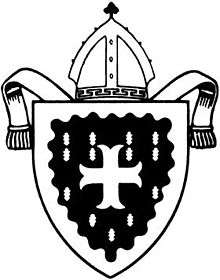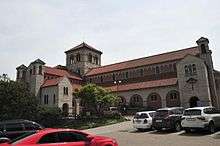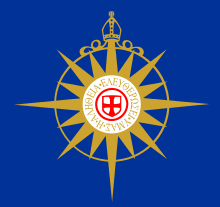Anglican Church of Korea
| Anglican Church of Korea | |
|---|---|
 The Official Emblem of the Anglican Church of Korea | |
| Primate | Onesimus Park, Bishop of Busan, Presiding Bishop of Korea |
| Headquarters | Seoul |
| Territory | Korea (North Korea and South Korea) |
| Members | 65,000[1] |
| Website | http://www.skh.or.kr/ |
| Anglican Church of Korea | |
| Hangul | 대한성공회 |
|---|---|
| Hanja | 大韓聖公會 |
| Revised Romanization | Daehan Seonggonghoe |
| McCune–Reischauer | Taehan Sŏnggonghoe |
The Anglican Church of Korea is the province of the Anglican Communion in North and South Korea. Founded in 1889, it has over 120 parish and mission churches[1] with a total membership of roughly 65,000 people.[1]
History
Birth of the Anglican Church of Korea
The birth of the Anglican Church of Korea can be traced back to November 1, 1889, when Bishop Charles John Corfe was ordained at Westminster Abbey and inaugurated as the first diocesan bishop of Joseon (Korea). With his colleagues who had been invited to join the mission, he arrived in Incheon Port on 29 September 1890. Nae-dong Anglican Church[] which is the first Anglican Church in Korea was established by him and Eli Barr Landis (1865-1898) on Sep. 30, 1891 at Nae-dong, Jung-gu, Incheon. He initiated his work in the Seoul area, including Gyeonggi and Chungcheong provinces. He first opened a number of educational institutions, medical facilities and social work centers across the country, such as the Sinmyeong (Faith and Enlightenment) schools and the hospitals in the vicinities of Incheon, Yeoju and Jincheon as well as the orphanages in Suwon and Anjung. The Anglican missionaries also sought possible ways for the church to be integrated into Korean culture. As a result of that effort, there are several Anglican Church buildings which were constructed in the traditional Korean architecture and which survive today such as those on Ganghwa Island. In addition, the early missionaries made pioneering contributions to Korean studies.
Early missionary work
Beginning in 1923 mission work was actively carried out in the northern part of the peninsula such as Pyongan and Hwanghae Provinces. To train the local clergy St. Michael's Theological Institute, the former institution of the present Sungkonghoe University, was established in 1923, followed by the Society of the Holy Cross (convent) in 1925. Also, the cathedral Church of St. Mary the Virgin and St. Nicholas in downtown Seoul was initially constructed in 1924 and is now well known for its unique Romanesque architecture as it is the only one in this fashion in the orient, together with its mosaic murals.
Japanese colonial rule
Due to considerable difficulties with the language barrier, personal health problems, and other incidents, the mission work had little success throughout the later years, especially during the 36-year period of the Japanese colonial rule. This colonial rule caused significant obstacles to Church development in Korea, primarily because those missionaries appeared to have an indifferent attitude to the Korean independence movement at that time.
First native bishop

Despite such an unfavorable situation as illustrated, the first native Korean bishop, Lee Cheon Hwan, was ordained in 1965 after 20 years had lapsed since liberation from Japanese rule. Thus the original Korean mission diocese was formed into the two dioceses of Seoul and Daejeon, followed by the separate additional forming of the Diocese of Busan in 1974. In 1974, he received an honorary CBE from Queen Elizabeth II. He died on 26 March 2010.
Recent expansion
Since the 1970s the Anglican Church has increasingly expanded through opening a number of new churches across country. St Peter's School was founded in 1975 to provide special needs children with effective special education as needed. St. Michael's Theological Seminary was also upgraded to be accredited by the government in 1982 and 10 years later it was again formally upgraded and expanded as a university to satisfies the peoples' great needs in the coming new era.
The three dioceses continued steady growth in numbers of churches and social evangelization under the auspices of the second and third generations of Korean bishops. The Church has thus been active in constructing new church buildings, along with its continued efforts in opening the new additional churches since the mid-1980s. In this context the Board of Mission and Education has played a timely role in offering education and training programs.
On occasion of its centennial anniversary on September 29, 1990, the Anglican Church of Korea reaffirmed its intent under the theme. "Jesus Christ, Life of the Nation", to continue proclaiming the message of life to the people and expediting the peaceful reunification of Korea as desired.
The Provincial Constitution of the Anglican Church of Korea was declared on September 29, 1992 and the first Korean primate was inaugurated on April 16, 1993. Thus, the Church finally has become an independent national church.
Structure and leadership
The church was previously under the authority of the Archbishop of Canterbury. To mark independence in 1993, the Archbishop of Canterbury handed his authority as Metropolitan and Primate to the first Archbishop of Korea. The church now forms a single metropolitical province, consisting of three dioceses: Seoul, Busan, and Daejeon. The primacy rotates between the three; thus the current Bishop of Busan is also the Archbishop of Korea and Primate of the Church.
Archbishops of Korea
- 1993-?: Simon Songsu Kim, Bishop of Seoul
- ?-? : Francis Park, Bishops of Seoul
- ?–1996: Bundo Kim Chae-hon, Bishop of Busan
- 1997-?: Matthew Chung, Bishop of Seoul
- ?-2000: Paul Hwan Yoon, Bishops of Daejeon
- ?-2010: Solomon Jong Mo Yoon, Bishop of Busan
- 2010-?: Paul Kim, Bishop of Seoul
- 2017 – present: Onesimus Dongsin Park, Bishop of Busan
Diocese of Seoul
The current Diocese of Seoul was founded as the Joseon (Korea) diocese, covering all the Korean peninsula, in 1889. It was split in 1965, to create Taejon diocese, at which point it became Seoul diocese. The current bishop is Peter Lee.
Bishops in Korea
The Bishop in Korea was an Anglican missionary appointment[2] from 1889 [3] to 1965 when the diocese was divided.[4]
| Tenure | Incumbent | Notes |
|---|---|---|
| 1889 to 1905 | Charles Corfe | (1843–1921) |
| 1905 to 1910 | Arthur Turner | (1862–1910) |
| 1911 to 1930 | Mark Trollope | (1862–1930) |
| 1931 to 1954 | Cecil Cooper | (1882–1964) |
| 1955 to 1965 | John Daly | (1901–1985) Became first Bishop of Daejeon |
- 1951-1953: Acting bishop Arthur Chadwell, Assistant Bishop
Bishops of Seoul
- 1965-1985: Paul Ch'on-Hwan Li (Paul Lee, First Native Bishop)
- 1985-1995: Simon Songsu Kim
- 1995-2005: Matthew Chul-bum Chung
- 2005-2009: Francis Gyeong-jo Park
- 2009-2017: Paul Kim
- 2017-present: Peter Lee
External links
Diocese of Daejeon
The Diocese of Daejeon is the Anglican Church in that part of South Korea that includes North and South Chungehong Provinces; North and South Cholla Provinces and South Kangwon.[5] It was erected from the Joseon diocese in 1965 and split in 1974 to erect Busan diocese.
Bishops of Daejeon
- 1965-1968: John Daly
- 1968-1974: Richard Rutt
- 1974-1987: Mark Pae
- 1987-2003: Paul Yoon[6]
- 2003-?: Andrew Shin[7]
- Michael Kwon
- Moses Yoo
External links
Diocese of Busan
Busan diocese was erected from the Diocese of Daejeon in 1974.
Bishops of Busan
- 1974-1987: William Choi
- 1987-1997: Bundo Kim
- 1994-2000: Joseph Dae Yong Lee
- 2000-?: Solomon Yoon
- ?-2013: Onesimus Park
External links
Social issues
The Anglican Church of Korea has clergy and members reflecting diverse views. The church ordains women as priests and has been doing so since 2001.[8] Regarding issues of human sexuality, some clergy, congregations, and members of the denomination have been affirming and supportive of LGBT rights including by participating in Pride events.[9][10] The Anglican Church in Korea is considered to be more open toward homosexuality and is openly discussing the matter.[11] One cleric, representing the Anglican Church in a Korean Christian dialogue, presented a "let's see" approach regarding homosexuality.[12]
See also
References
- 1 2 3 "World Council of Churches - Anglican Church of Korea". Archived from the original on 2011-05-21. Retrieved 2009-12-18.
- ↑ Details of mission
- ↑ The Times, Saturday, Nov 02, 1889; pg. 9; Issue 32846; col C CONSECRATION OF THREE NEW BISHOPS:Reading, Derby and Corea (Sic)
- ↑ Division details
- ↑ Crockford's Clerical Directory 1975-76 London: Oxford University Press, 1976 ISBN 0-19-200008-X
- ↑
- ↑
- ↑ "Korean Catholic priests become Anglican and marry". ncronline.org. National Catholic Reporter. Retrieved February 22, 2016.
- ↑ "동성애 축제, 미국 교단은 지지, 한인 교회는 걱정 - 뉴스앤조이" (in Korean). Retrieved 2017-05-04.
- ↑ Hazzan, Dave. "Why Korea's Christian churches are leading the anti-gay charge: And how a handful of LGBT-affirming churches are fighting back". dailyxtra.com. Daily Xtra. Retrieved February 22, 2016.
- ↑ "교회에 번지는 '동성애' 논란…동성애자가 목사 안수를 받을 수 있는가 - 목장드림뉴스" (in Korean). Retrieved 2017-05-04.
- ↑ "동성애 문제 놓고 목사 신부 갈렸다 - 뉴스앤조이" (in Korean). Retrieved 2017-05-04.
